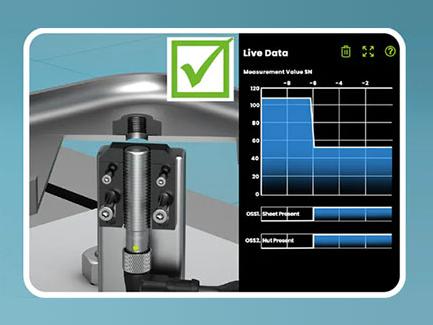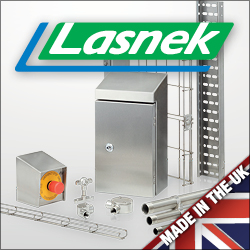
Posted to News on 7th Nov 2023, 19:00
Contrinex smart sensors and PocketCodr stop assembly going nuts

When a metal-assembly manufacturer was looking to develop a sensor-based system to detect the presence or absence of multiple weld nuts on a single panel, reliably and repeatably, it turned to Contrinex.
Weld nuts are an essential element of many metal assemblies, providing threaded mounting points in sheet-metal parts. They are also a source of frustration for production engineers as missing weld nuts are a frequent cause of scrap parts, and potential customer complaints, which for example in the automotive industry could include substantial penalties.
The hand-held PocketCodr module and companion app puts the configuration of Contrinex’s DMS inductive smart sensors into the hands of production engineers on their phone or tablet. Therefore they can quickly and easily configure sensors to robustly detect a missing nut across multiple variants of assembly and quickly adapt to later new assembly designs. PocketCodr enables this to be done with no coding expertise and no detailed knowledge of IO-Link.
The early detection of non-conforming parts and assemblies is essential for minimising manufacturing reject costs for example by avoiding downstream disruption. Failing to do so risks costly downtime, rework and potentially production scrap or incorrect finished parts. Automated assembly processes, particularly in high-volume sectors like automotive and white goods require robust, reliable detection systems to identify faulty items.
Steel assemblies that incorporate weld-nut fasteners are widely used because weld nuts offer a low-cost, easily automated means of producing strong, threaded mounting points in relatively thin-gauge sheet-metal parts. A missing weld nut typically renders an assembly unusable but might go undetected in the absence of an in-line detection system that operates in real time.
A metal-assembly manufacturer was looking to develop a sensor-based system to detect the presence or absence of multiple weld nuts on a single panel, reliably and repeatably. Additionally, the ability to repurpose a test station quickly and with minimal interruption to production to accommodate alternative parts and geometries in future was desired. Commonality of sensors was a priority, with a target of using off-the-shelf intelligent or smart sensors that can be reconfigured without high-level programming skills.
Contrinex’s high-precision Digital distance-Measurement smart Sensors (‘DMS’) were ideal for this application, with the hand-held PocketCodr configurator putting the monitoring and configuration of the sensors into the hands of the engineer on a tablet or phone and removing the need for any coding.
Multiple sensors are mounted into quick-change, adjustable fixtures to perform real-time measurements that confirm the presence or absence of individual weld nuts or elements at predetermined positions on a jig.
M12 metal-bodied embeddable DMS Smart sensors were chosen for being compact yet robust. The IO-Link-enabled inductive sensors ensure highly accurate no-contact detection, with operating distances up to 4 mm. The ability to easily implement built-in delay and timer functions helps ensure that the sensors stabilise before switching, which prevents false positives from triggering the rejection of good parts.
The modular and adjustable bracketry enables assembly jigs to be easily produced for differing sizes and geometries of assembly and similarly, the use of the PocketCodr enables fast, simple configuration of the sensors and requires no coding expertise and no detailed knowledge of IO-Link. The technician simply connects each sensor in turn to the PocketCodr device and uses the companion app installed on a smartphone or tablet to set and monitor the switching points. As a panel is presented, the measurement value is displayed together with the high/low status of one or more internal switching signals.
The technician assigns the output switching signal (OSS1) to trigger on a user-defined condition, in this instance, when only SSC1 is high. Every aspect of configuration is driven by intuitive selection via the app, and on completion, the sensor is simply reconnected to the machine’s control system.
The IO-Link connectivity also provides an easy interface to the PLC control system. After initial calibration, each sensor’s configuration is stored automatically on the local IO-Link Master; this allows plug-and-play replacement of sensors should the need arise, without any loss of functionality and without any need for recalibration.


















